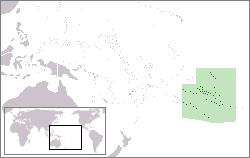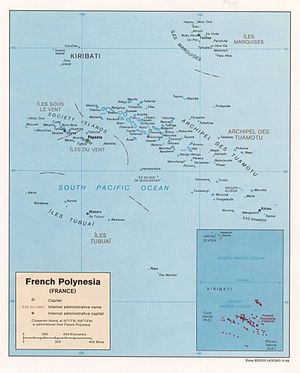French Polynesia
2007 Schools Wikipedia Selection. Related subjects: Countries; Geography of Oceania (Australasia)
| Polynésie française Pōrīnetia Farāni |
|||||
|
|||||
| Motto: "Tahiti Nui Mare'are'a" | |||||
| Anthem: ’Ia ora na ’o Tahiti nui | |||||
| Capital (and largest city) |
Papeete | ||||
| Official languages | French | ||||
|---|---|---|---|---|---|
| Government | Dependency | ||||
| - President | Jacques Chirac | ||||
| overseas dependency | |||||
| - Bastille Day | 14 July (1789) | ||||
| Area | |||||
| - Total | 4,167 km² ( 173rd) 1,609 sq mi |
||||
| - Water (%) | 12 | ||||
| Population | |||||
| - July 2006 estimate | 260,338 ( 181st) | ||||
| - 2002 census | 245,405 | ||||
| - Density | 64/km² ( 130th) 166/sq mi |
||||
| GDP ( PPP) | 2003 estimate | ||||
| - Total | $4.58 billion ( not ranked) | ||||
| - Per capita | $17,500 (2003 est.) ( not ranked) | ||||
| HDI (n/a) | n/a (n/a) ( n/a) | ||||
| Currency | CFP franc ( XPF) |
||||
| Time zone | ( UTC-10) | ||||
| Internet TLD | .pf | ||||
| Calling code | +689 | ||||
French Polynesia (French: Polynésie française, Tahitian: Pōrīnetia Farāni) is a French "overseas collectivity" (French: collectivité d'outre-mer, or COM) with the particular designation of "overseas country" (French: pays d'outre-mer, or POM) in the southern Pacific Ocean. It is made up of several groups of Polynesian islands, the most famous island being Tahiti in the Society Islands group, which is also the most populous island, and the seat of the capital of the territory ( Papeete). Although not an integral part of its territory, Clipperton Island is administered from French Polynesia.
Politics
Politics of French Polynesia takes place in a framework of a parliamentary representative democratic French overseas collectivity, whereby the President of French Polynesia is the head of government, and of a pluriform multi-party system. Executive power is exercised by the government. Legislative power is vested in both the government and the Assembly of French Polynesia. Between 1946 and 2003, French Polynesia had the status of an overseas territory.(French: territoire d'outre-mer, or TOM). In 2003 it became an overseas collectivity (French: collectivité d'outre-mer, or COM). Its statutory law of 27 February 2004 gives it the particular designation of "overseas country" to underline the large autonomy of the territory.
Administration
Between 1946 and 2003, French Polynesia had the status of an overseas territory (French: territoire d'outre-mer, or TOM). In 2003 it became an overseas collectivity (French: collectivité d'outre-mer, or COM). Its statutory law of 27 February 2004 gives it the particular designation of "overseas country" to underline the large autonomy of the territory.
Administrative divisions
French Polynesia has five administrative subdivisions (French: subdivisions administratives):
- Windward Islands (French: (les) Îles du Vent or officially la subdivision administrative des Îles du Vent) (the two subdivisions administratives Windward Islands and Leeward Islands are part of the Society Islands)
- Leeward Islands (French: (les) Îles Sous-le-Vent or officially la subdivision administrative des Îles Sous-le-Vent) (the two subdivisions administratives Windward Islands and Leeward Islands are part of the Society Islands)
- Marquesas Islands (French: (les) (Îles) Marquises or officially la subdivision administrative des (Îles) Marquises)
- Austral Islands (French: (les) (Îles) Australes or officially la subdivision administrative des (Îles) Australes) (including the Bass Islands)
- Tuamotu-Gambier (French: (les) (Îles) Tuamotu-Gambier or officially la subdivision administrative des (Îles) Tuamotu-Gambier) (the Tuamotus and the Gambier Islands)
Geography
The islands of French Polynesia have a total land area of 4,167 square kilometres (1,622 sq. mi) scattered over 2,500,000 square kilometres (965,255 sq. mi) of ocean.
It is made up of several groups of islands, the largest and most populated of which is Tahiti.
The island groups are:
- Austral Islands
- Bass Islands often considered part of the Austral Islands
- Gambier Islands often considered part of the Tuamotu Archipelago
- Marquesas Islands
- Society Islands (including Tahiti)
- Tuamotu Archipelago
Aside from Tahiti, important atolls and islands, and island groups in French Polynesia include Ahe, Bora Bora, Hiva `Oa, Huahine, Maiao, Maupiti, Mehetia, Moorea, Nuku Hiva, Raiatea, Tahaa, Tetiaroa, Tubuai, and Tupai.
Economy
French Polynesia has a moderately developed economy, which is dependent on imported goods, tourism, and the financial assistance of mainland France. Tourist facilities are well developed and are available on the major islands.Also, as the noni fruit from these islands is discovered for its medicinal uses, people have been able to find jobs related to this agricultural industry.
The legal tender of French Polynesia is the CFP franc; merchants have been reported to accept other currencies very readily, but many tourists have been disappointed and inconvenienced through assuming they can use U.S. dollars and other foreign currencies.
Agriculture: coconuts, vanilla, vegetables, fruits.
Natural resources: timber, fish, cobalt.
The major export of French Polynesia is their famous black Tahitian pearls.
Demographics
Total population at the 2002 census was 245,405 inhabitants, 83% of whom are Polynesian, 12% white, and 5% East Asian (mainly Chinese). In 2002, 69% of the population of French Polynesia lived in the island of Tahiti alone. The urban area of Papeete, the capital city, has 127,635 inhabitants (2002 census).
French is the official language of French Polynesia.*
- <Loi organique n° 96-312 du 12 avril 1996portant statut d'autonomie de la Polynésie française> Article 115-1) Le français est la langue officielle, la langue tahitienne et les autres langues polynésiennes peuvent être utilisées.
Transport
While most major roads are paved and well-maintained, many secondary roads are not. Traffic is brisk and all types of vehicles and pedestrians jockey for space on narrow streets. Crosswalks are marked and the law requires that motor vehicles stop for pedestrians; however, this is not always done. Tourists should exercise caution when driving, particularly at night.
Education
Education is also provided by France. French Polynesia has a University, the Université de la Polynésie Française (UPF, "University of French Polynesia"), located in Faa'a, Tahiti. It is a small university of around 2,000 students. Luise Peltzer, former minister of culture of French Polynesia has been elected president of the University for five years. There are about sixty researchers at the university, including physicists Pascal Ortega (lightning studies) and Alessio Guarino ( nonlinear physics). In the Human Sciences department, sociologist Laura Schuft deserves mention for her study on the integration of mainland French workers in Tahiti.
Famous people of French Polynesia
- Marco Namouro, writer (1889-1968)



